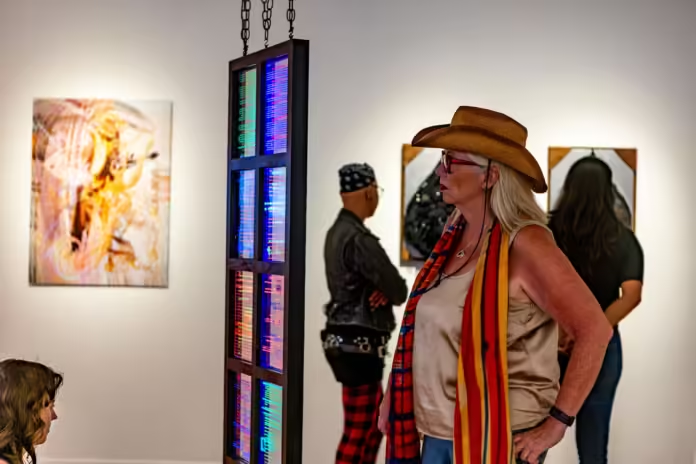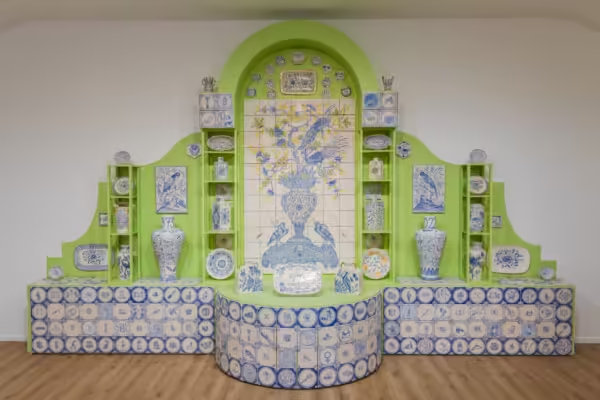
Must-See Exhibition Showcases Feminist Strength & Resistance at Angels Gate Cultural Center
Angels Gate Cultural Center presents UPEND Female Experience and Activism. Curated by Cecelia Koger, the exhibition closes Aug. 17 with a reception from 1 to 3 p.m. and artist talk for UPEND at 3 p.m. in the gallery.
Providing a counter to the increased societal distress of a return to toxic hyper-masculinity, UPEND depicts strength and resistance in a decidedly female-identifying voice — upending expectations for what can and cannot be said, and how women should act.
UPEND is both a highly relevant and noteworthy exhibition. It arose from gathering women artists together in a discussion on women’s and feminist issues. At one point curator Cecelia Koger understood that these artists had much to discuss.
Koger, via email, explained that her criteria for framing the exhibit centered on the question: do women’s issues, like reproductive rights and bodily autonomy, need more awareness now because government forces are reversing women’s rights, or because many of those issues are largely ignored and only talked about in whispers?
Koger considered both the loud and more overt topics of reproductive rights, the #MeToo Movement, and political activism led by women. These were contrasted with the more silent battles and minimized injustices such as the invisibility of women as they age and the objectifying male gaze, disproportionate rates of Black maternal mortality and postpartum depression, medical reproductive trauma and mother-child separation, pressures of conforming to stereotypes of femininity and the fact that women are under impossible standards and often self-sacrifice.
UPEND is an exhibition you will not soon forget. It opens space for contemplation of female experiences, empathy, and even consciousness.
Loud and Overt
Suzanna Scott highlights bodily form through her sculpture, which often transposes benign objects. Coin Cunts stand as a visual symbol of empowerment and equality for all people with a vulva, as distinct as every human is a unique individual. On display are the insides of the tiny purses. These folded, shaped, and sewn specimens cover many topics: reproductive rights, vulvas and female genital mutilation, all with visible stitches. Once discovered, the sculptures of delicate form elicited much attention and contemplation. Scott’s works aim to raise awareness for many causes around the globe such as reproductive rights, sexual exploitation, bodily autonomy, FGM (female genital mutilation) and racial disparities in reproductive health.
Across the Line by Nonny de la Peña and Emblematic focuses on the first-person experience of a woman trying to access services at a Planned Parenthood. The viewer is the patient, encompassed by 360-degree experience, using both audio and visuals informed by actual transcriptions taken from real-life protestors embedded within a virtual-reality scene of crossing a picket line. In one scene, a protester tries to talk the patient out of going to Planned Parenthood and to instead go with him to a crisis pregnancy center or CPC (run by anti-abortion activists who try to coerce vulnerable people into remaining pregnant by misleading them about abortion procedures and contraception) while simultaneously passing judgment on the patient.
A poignant work is even more so now, with the overturning of Roe v. Wade.
Elyse Pignolet fiercely critiques systems of power that oppress women. The artist takes inspiration from global tradition and china painting, an art form that women spearheaded to derive income from home-based industries in the late nineteenth and early twentieth centuries. NoGods, No Masters lures viewers with ornate decorative aesthetics to create an “un-ladylike” encounter with privately discussed icons of female experience – a tampon, speculum, rape, and slurs aimed a degradation. Every woman will recognize the statements and images on the ceramics. They are important to document: like the ridiculous contrast of “What were you wearing?” and “Prude.” Some are lighthearted, like an image of a butterfly and gold hoop earrings. Unapologetic in her messaging, Pignolet’s work capitalizes on confrontation to highlight social and political injustices, thereby empowering women’s experiences.
She Loves Collective is an alliance of female artists united by a shared vision of harnessing the transformative power of art for social change. The Rifles Our Ancestors Didn’t Have raises awareness of the unprovoked aggression and destruction waged by Azerbaijan and Turkey against the Armenian enclave of Artsakh, also known as Nagorno-Karabakh. By occupying space with their united voices, She Loves Collective aims to engage the global community, which has largely remained silent. This performance acknowledges the strength of the Armenian people who survived the 1915 genocide carried out by the Ottoman Turks in addition to the recent devastation of Nagorno-Karabakh.
Silent Battles, Minimized Injustices
Artist Andrea Patrie’s work is autobiographical. In her artist statement, Patrie explains this work encompasses the insecurity she feels financially, emotionally, and physically as she ages and how those feelings intensify with age. Her work is a direct commentary on how it feels to navigate those roles.
Patrie’s painting, Time to Prepare for What’s Coming Your Way, depicts a seemingly middle-aged woman in a reclined posture, like Venus. She has no identifiable qualities as her face is almost mask-like, with gray orbs and red pupils for eyes and a paste-like complexion. She looks melancholy. The painting’s colors — with dream-like gestures of blending lines, and slight blurriness — are soft, yet, the pigments are deep. Wearing only a mismatched bra and underwear, exposing signs of menstruation, Patrie’s piece presents many contrasts in the life of this woman.
A Jezebelle Wrapped In Yarn, Left Barefoot and Pregnant; Hidden Mother 2
Kennedi Carter’s beautiful photographic pieces immediately draw you in. Her “Jezebelle” depicts Carter lying on a couch in a dimly lit room. She’s on her side nearly prone, her belly rests on the cushion, her arms on the couch arm. Dressed in a backless crochet dress, her serious eyes look to the distance. In Hidden Mother 2, Carter appears in silhouette as the warmth of soft light behind her vibrantly illuminates a wooden paneled wall.
Carter draws from her ancestral canon of Black and Southern experience through skin, texture, intimacy, home and community. Following the artist’s emergency cesarean-section of her premature son, Carter was left with physical and emotional trauma. Her son lived in the NICU for 82 days. When not at his bedside, Carter used her practice to help digest her trauma. The artist photographed herself in a prosthetic belly, embodying the act of fabrication, envisioning a timeline in which she had the chance to carry her son to term. Childbirth and postpartum depression traumas are rarely considered in public consciousness, indicative of a patriarchal tradition minimizing women’s pain and experiences. This issue is compounded by systemic racism experienced by Black women in healthcare, where the maternal mortality rate for Black women is 2.6 times higher than for white women (CDC, National Center for HealthStatistics, 2021).
Kayla Tange’s sculpture Intergenerational Toxins, manifests grief, cancer, endometriosis surgeries, the mourning for loss of time, ancestors, her mother’s early death, and viewing her own body as a monster. Tange dealt with medical issues including endometriosis and its effects on fertility. All in black, two framed teardrop-shaped, pillow-like pieces made of entangled fabrics represent endometrial tissue. The piece is adorned lightly with glitter, and pasties from Tange’s costume during her days as a stripper, amid interwoven forms. Tassels of bulbous fabric hang from the entanglements. They are beautiful monsters.
The work is placed in conversation with A Chance to Be Seen (and not disappear when feelings appear), a work exploring the artist’s own displacement with a sculpture of translated letters between the artist and her biological mother alongside transactive adoption documents. International adoption in Korea, a highly profitable export since the Korean War, has displaced over 150,000 children. In Tange’s autobiographical work, she etched these letters and documents in colored inks onto each side of glass panes in both English and Korean. The viewer may read family medical histories and personal anecdotes and between Tange’s birth mother and herself. The artist has since met her mother.
Ibuki Kuramochi
Kuramochi’s multimedia and performance work delves into the phenomenal body, the womb, and the female form, intertwining them with posthuman feminist concepts and technology. The video installation Talk to Her is a fusion of sexuality, self-dissociation, and hyper-feminine digital context, aimed at exploring the intricate interplay between the female body and feminist politics. The artist’s body is depicted along with lace, pearls, metal and mirror. It’s intimate and voyeuristic, yet gentle and inviting with the digital play of forms and colors in pink, black, white silver and flesh tone.
Watercolor artist Sheli Silverio creates human-scale portraits. Her works in UPEND, represented as paper dolls, explore understanding personal identity within the confines of society’s idea of womanhood, symbols of sexuality, vulnerability, confidence, intelligence and physicality. Each piece is a self-portrait.
Silverio’s Daddy Sekhmet invokes the female lion-headed goddess of destruction and healing, Sekhmet, in Egyptian mythology. The life-sized goddess stands within an ornately designed frame, her mouth agape as if roaring, she holds Silverio’s decapitated head. In this self-portrait, the artist considers the many ways in which women must accept their rage and even activate states of anger for self-protection and eventual healing to overcome the self-sacrificial projections of societal expectations. In consideration of the title, children of Sekhmet can tap into a primal rage that increases their strength, speed, agility and stamina.
Ultimately, with UPEND, Koger feels she scratched the surface on many nuanced topics
“All of these topics result from patriarchal systems that oppress women,” Koger wrote, “and it is my belief that there is a current resurgence of hypertoxic masculinity attempting to set women back, thus the need for this exhibition now. I had an overall goal of radical empathy, by sharing the lived experiences of women I hope that these stories and perspectives can motivate kinder and more equitable treatment of women.”
Details: www.angelsgateart.org


